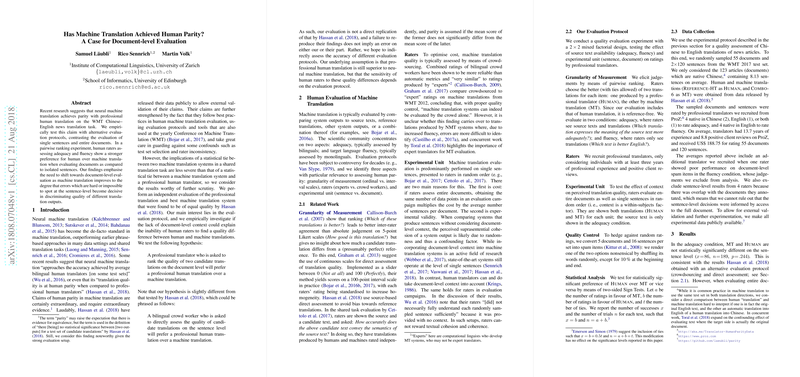Document-Level Evaluation in Machine Translation: Reassessing Human Parity
The paper, "Has Machine Translation Achieved Human Parity? A Case for Document-level Evaluation," rigorously investigates the claim that neural machine translation (NMT) can achieve parity with professional human translation, particularly in the context of the WMT Chinese--English news translation task. The research conducted by Samuel Läubli, Rico Sennrich, and Martin Volk, focuses on assessing the validity of these claims using a different evaluation protocol emphasizing document-level context over isolated sentences.
Context and Motivation
The field of machine translation (MT) has seen remarkable advancements with neural approaches outperforming earlier latent-variable and phrase-based models. Claims regarding NMT reaching human parity have emerged, elated by evidence like that provided by Hassan et al. (2018), where machine translations supposedly match the quality of professional human translations on certain tasks. This paper challenges the robustness of these claims, suggesting that existing evaluation methods, largely conducted at the sentence level, might obscure significant quality differentiations that are more apparent at the document level.
Methodological Approach
The authors devise an empirical paper structured around a 2\,×\,2 mixed factorial design, incorporating two key factors: (1) source text availability categorized into adequacy (source and translation available) and fluency (only translations available), and (2) experimental unit delineated by isolated sentence or entire document evaluations. Importantly, the experiment recruits professional translators instead of crowd workers, aiming to leverage nuanced expertise, and employs pairwise ranking rather than absolute rating, to account for relative differences in quality more effectively.
Key Findings
The document-level evaluations revealed distinct tendencies; in contrast to sentence-level analysis where human and MT parity was largely equivocal, document-level evaluations showed a statistically significant preference for human translations. This divergence underscores potential inadequacies in existing evaluation methodologies that may overlook context-dependent translation deficiencies such as lexical consistency, coherence, and discourse-level errors within machine-generated text. Notably, the preference for human translation remained pronounced even among assessments focused solely on translation fluency—a dimension previously thought to be a strength of neural systems.
Implications and Future Directions
The notable emphasis on document-level evaluation has substantial implications for both theoretical inquiry and practical applications. As machine translation continues to evolve, the necessity for evaluation protocols that reflect the complexities of cohesive, multi-sentence discourse becomes increasingly crucial. The research illuminates the potential pitfalls of equating sentence-level parity with holistic equivalence to human translation capabilities across varied contexts.
Prospective advancements might include the development of systems that natively incorporate discourse-aware translation mechanisms and the cultivation of document-level training datasets to bridge observed gaps. Additionally, refining evaluation metrics to incorporate these dimensions, perhaps through enhanced automated metrics aligned closer with human judgment, would be a natural extension of this work.
In conclusion, while the investigation does not refute the impressive capabilities of modern NMT systems, it advocates for a recalibrated perspective on evaluation practices, ensuring that assessments are as comprehensive and contextually aware as the translation tasks themselves. This step is essential for both accurately gauging the progress of machine translation technology and guiding future innovations.
